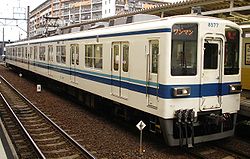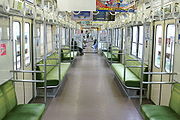
Tobu 8000 series
Encyclopedia
The is a commuter electric multiple unit
operated by Tobu Railway
in Japan since 1963.
A total of 712 vehicles were built between 1963 and 1983, making this the most numerous EMU type operated by a private railway operator in Japan.
and Tsuha Sharyō factory in Nishiarai, Tokyo.
In May 1977, the first 8-car 8000 series set (8173) was delivered for use on the Tōjō Line.
October 1979 saw the last two digits of individual car running numbers exceed 99, resulting in some cars receiving 5-digit (8xxxx) running numbers.
The last two sets built, 81120 and 8580, were delivered in 1983.
 Life-extension refurbishment began in 1986, and sets treated from 1987 received redesigned cab ends based on the 6050 series design. Sets refurbished from 1997 onward received HID
Life-extension refurbishment began in 1986, and sets treated from 1987 received redesigned cab ends based on the 6050 series design. Sets refurbished from 1997 onward received HID
headlights and LED
external destination indicators, replacing the original roller blind type.
2001 saw the first appearance of 2-car sets modified for driver-only-operation. This included the addition of an automated bilingual (Japanese and English) passenger announcement system, internal LED passenger information displays, and external speakers.
Some of the remaining unrefurbished sets also received LED destination indicators.
 From 2004, five 8-car sets were reformed to create pairs of 3-car 800 and 850 series driver-only-operation sets for use on Sano
From 2004, five 8-car sets were reformed to create pairs of 3-car 800 and 850 series driver-only-operation sets for use on Sano
and Kiryū Line
services. This conversion involved adding new cabs to former MoHa8300 and MoHa8200 intermediate cars.
The new sets are formed as follows.
 The Kameido Line uses 2-car trainsets modified for driver-only operation.
The Kameido Line uses 2-car trainsets modified for driver-only operation.
services include 800 and 850 series 3-car driver-only-operation sets introduced from the start of the revised timetable on 18 March 2006.
services include 800 and 850 series 3-car driver-only-operation sets introduced from the start of the revised timetable on 18 March 2006.
 The Tōjō Line fleet based at Shinrinkōen Depot consists of 2-, 4-, 6-, and 8-car trainsets. These are operated as 10-car formations for services to/from Ikebukuro
The Tōjō Line fleet based at Shinrinkōen Depot consists of 2-, 4-, 6-, and 8-car trainsets. These are operated as 10-car formations for services to/from Ikebukuro
and as 6-car formations for local driver-only-operation services north of Ogawamachi
.
 From the start of the revised timetable on 14 June 2008, only refurbished 4-car driver-only-operation sets are used on the Ogose Line
From the start of the revised timetable on 14 June 2008, only refurbished 4-car driver-only-operation sets are used on the Ogose Line
.
 When first built, the 8000 series sets were finished in a livery of "royal beige" and "international orange". From May 1974, sets were repainted into a simpler all-over livery of "sage cream". From 1985, sets were repainted into a new livery of "jasmine white" with dark and light blue bodyside stripes. As of 2008, all 8000 series sets operate in this livery.
When first built, the 8000 series sets were finished in a livery of "royal beige" and "international orange". From May 1974, sets were repainted into a simpler all-over livery of "sage cream". From 1985, sets were repainted into a new livery of "jasmine white" with dark and light blue bodyside stripes. As of 2008, all 8000 series sets operate in this livery.
One 6-car set (8108) was repainted into the original beige and orange livery between October 2004 and June 2005 to mark the 90th anniversary of the Tōjō Line. This unit was subsequently returned to standard livery.
Electric multiple unit
An electric multiple unit or EMU is a multiple unit train consisting of self-propelled carriages, using electricity as the motive power. An EMU requires no separate locomotive, as electric traction motors are incorporated within one or a number of the carriages...
operated by Tobu Railway
Tobu Railway
is a Japanese commuter railway company in the Greater Tokyo Area as well as an intercity and regional operator in the Kantō region. It operates in Tokyo, Saitama, Chiba, Tochigi, and Gunma Prefectures...
in Japan since 1963.
A total of 712 vehicles were built between 1963 and 1983, making this the most numerous EMU type operated by a private railway operator in Japan.
Production
The first 8000 series appeared in November 1963 as 4-car sets. These were joined from December 1964 by 2-car sets (formed MoHa8500 + KuHa8600). Between 1971 and 1972, 14 pairs of additional intermediate cars (SaHa8700 + MoHa8800) were built and inserted into 4-car sets 8101 to 8114 to lengthen them to six cars. 8000 series trains built up to this point were not equipped with air-conditioning, but from June 1972, three 6-car air-conditioned sets (8156 to 8158) were delivered. The originally non-fitted sets were also modified with air-conditioning from October 1973 until 1983 at the Alna Kōki (now Alna Sharyō) factory in OsakaOsaka
is a city in the Kansai region of Japan's main island of Honshu, a designated city under the Local Autonomy Law, the capital city of Osaka Prefecture and also the biggest part of Keihanshin area, which is represented by three major cities of Japan, Kyoto, Osaka and Kobe...
and Tsuha Sharyō factory in Nishiarai, Tokyo.
In May 1977, the first 8-car 8000 series set (8173) was delivered for use on the Tōjō Line.
October 1979 saw the last two digits of individual car running numbers exceed 99, resulting in some cars receiving 5-digit (8xxxx) running numbers.
The last two sets built, 81120 and 8580, were delivered in 1983.
Refurbishment

High-intensity discharge lamp
High-intensity discharge lamps are a type of electrical lamp which produces light by means of an electric arc between tungsten electrodes housed inside a translucent or transparent fused quartz or fused alumina arc tube. This tube is filled with both gas and metal salts. The gas facilitates the...
headlights and LED
LEd
LEd is a TeX/LaTeX editing software working under Microsoft Windows. It is a freeware product....
external destination indicators, replacing the original roller blind type.
2001 saw the first appearance of 2-car sets modified for driver-only-operation. This included the addition of an automated bilingual (Japanese and English) passenger announcement system, internal LED passenger information displays, and external speakers.
Some of the remaining unrefurbished sets also received LED destination indicators.
800 and 850 series conversion

Tobu Sano Line
The is railway line in Japan, operated by the private Tōbu Railway company from Tatebayashi Station in Tatebayashi city, Gunma Prefecture to Kuzū Station in Sano, Tochigi Prefecture....
and Kiryū Line
Tobu Kiryu Line
The is a railway line of Japanese major private railway company Tōbu Railway in Tokyo. The line is a 20.3 km branch off the Isesaki Line at Ōta Station, southbounds to Akagi Station.-Stations:All stations are located in Gunma Prefecture.-External links:...
services. This conversion involved adding new cabs to former MoHa8300 and MoHa8200 intermediate cars.
The new sets are formed as follows.
Isesaki Line
The Isesaki Line fleet consists of 2-, 4-, and 6-car trainsets based at Kasukabe, Tatebayashi, and Shin-Tochigi depots. A fleet of 3-car 800 and 850 series trains converted from 8000 series units is also based at Tatebayashi Depot.Kameido Line

Kiryū Line
Kiryū LineTobu Kiryu Line
The is a railway line of Japanese major private railway company Tōbu Railway in Tokyo. The line is a 20.3 km branch off the Isesaki Line at Ōta Station, southbounds to Akagi Station.-Stations:All stations are located in Gunma Prefecture.-External links:...
services include 800 and 850 series 3-car driver-only-operation sets introduced from the start of the revised timetable on 18 March 2006.
Noda Line
The Noda Line fleet based at Nanakōdai Depot consists of 2-, 4-, and 6-car trainsets.Sano Line
Sano LineTobu Sano Line
The is railway line in Japan, operated by the private Tōbu Railway company from Tatebayashi Station in Tatebayashi city, Gunma Prefecture to Kuzū Station in Sano, Tochigi Prefecture....
services include 800 and 850 series 3-car driver-only-operation sets introduced from the start of the revised timetable on 18 March 2006.
Tōjō Line

Ikebukuro Station
is a railway station located in the Ikebukuro district of Toshima, Tokyo, Japan. With 2.71 million passengers on an average daily in 2007, it is the second-busiest train station in the world , and the busiest station in the Tobu, Seibu and Tokyo Metro networks. It primarily serves commuters from...
and as 6-car formations for local driver-only-operation services north of Ogawamachi
Ogawamachi Station (Saitama)
is a railway station in Ogose, Saitama, Japan, jointly operated by East Japan Railway Company and Tobu Railway.-Lines:Ogawamachi Station is served by the Hachikō Line between and , and also by the Tōbu Tōjō Line from in Tokyo.-Station layout:...
.
Ogose Line

Tobu Ogose Line
The is a 10.9 km mostly single-track branchline in Saitama Prefecture, Japan, which runs from Sakado Station on the Tōbu Tōjō Line to Ogose Station, connecting with the JR East Hachikō Line.-Service outline:...
.
Livery changes

One 6-car set (8108) was repainted into the original beige and orange livery between October 2004 and June 2005 to mark the 90th anniversary of the Tōjō Line. This unit was subsequently returned to standard livery.

